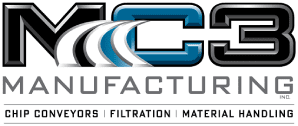Maintaining the right conveyor belt tension is vital to your conveyor system’s efficiency and longevity. A belt that’s too tight can wear out prematurely, while a loose belt may slip, resulting in costly repairs and downtime. Generally, proper belt tension is the lowest possible tension to minimize wear while not causing slippage.
Here, we will explore how to check conveyor belt tension and how to adjust a conveyor belt based on the most common tensioning methods.
Signs That Conveyor Belt Tension Is Off
Identifying improper belt tension early can prevent later problems. Watch for these common warning signs:
- Frequent stalling or belt slippage
- Frayed belt lacing
- Curling or cupping belt edges
- Uneven wear on belt edges
- Squealing or grinding noises
- Belt misalignment or frequent tracking issues
- Accumulation of belt residue under the machine
If you notice any of these symptoms, check and adjust the tension of your conveyor belt. Tackling the issue as soon as it’s detected helps minimize further damage to the belt and other conveyor components.
Common Conveyor Belt Tensioning Methods
Depending on your unique system, you can choose from several methods to adjust and maintain proper conveyor belt tension. The following are the most common approaches.
Jack-Screw Tension
Jack-screw tensioning is a straightforward method that involves turning the screws at the conveyor’s end to push the bearing block and add tension to the belt. This technique is often used for belt-tracking adjustments and must be performed equally on both ends of the roller. While simple and effective for initial tensioning, jack-screw tensioning comes with a risk of over-tensioning and doesn’t account for natural belt stretching over time. The jack-screw can also sometimes be difficult to access and adjust, leading to longer maintenance times.
Tip-Up Tail Tension
This method involves placing the end roller on a pivot mechanism that lifts the roller to extend and tension the belt. Since tip-up tensioning only sets the roller to a single position, this technique is generally used just for initial tensioning rather than adjustments and requires precise installation for optimal results. Jack-screw or other tensioning methods must be used for adjustments over time.
Pneumatic or Spring Tension
For longer or heavy-duty conveyor systems, pneumatic or spring tensioning offers a reliable solution. A pneumatic cylinder or spring applies consistent pressure to maintain belt tension, accommodating belt stretch automatically. This method tensions the belt by moving the ends of the lower tension roller equally, resulting in consistent tensioning over time. Unlike jack-screw and tip-up tail tensioning, pneumatic tensioning doesn’t require regular manual readjustment.
Rack and Pinion Tension
This method uses a compact rack-and-pinion system installed on the side of the conveyor frame. Operators manually tighten the belt without impacting tracking. This method minimizes the risk of over-tensioning but does require regular manual readjustments over time. Rack-and-pinion tensioning is a relatively low-maintenance option for smaller conveyor systems.
Contact MC3 Manufacturing
Checking and maintaining conveyor belt tension is critical for the long-term health and efficiency of your conveyor system. Whether you use jack-screw, pneumatic, or rack-and-pinion tensioning, performing regular maintenance is key. For expert guidance on checking or correcting your conveyor belt tensioner, turn to MC3 Manufacturing.
MC3 Manufacturing specializes in conveyor solutions that support diverse operational needs. As conveyor experts, we have the knowledge and skills to provide ongoing technical support to our customers as needed. Our core fabrication capabilities include:
- Scrap and chip conveyors
- Material handling systems
- Filtration systems
- Custom fabrication (with client-provided designs)
Let us help you optimize your conveyor system’s performance. For assistance with belt tensioning or other conveyor challenges, contact us or request a quote.



